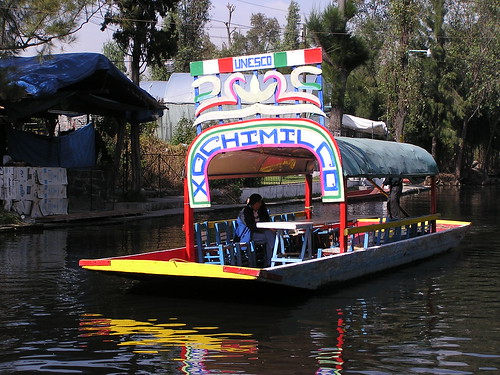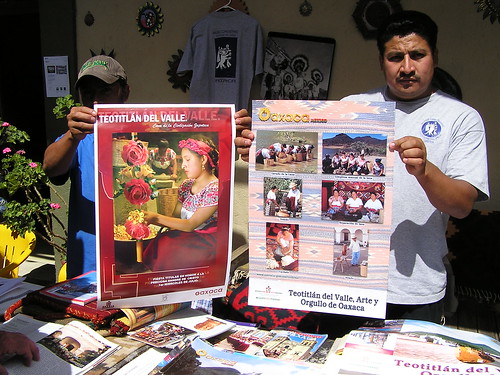How to Practice Responsible Travel and Ecotourism in Mexico and Central America
Article and Photos by Ron Mader
Latin America Correspondent and the Responsible Travel
Contributing Editor

|
|
Mexico City — Xochimilco. A UNESCO World Heritage Site since 1987.
|
Latin America is the cradle of ecotourism. First touted in 1983 by Hector Ceballos-Lascurain as a development strategy to preserve the wilderness and create employment in Celestún, Mexico, ecotourism was adopted by many countries, including Costa Rica and Ecuador, as a viable way to promote rural tourism and environmental awareness.
Costa Rica quickly became the poster child for green travel and ecotourism thanks to a plethora of scientific research and the success of the New Key guidebook (now in an impressive 18th edition!).
Global tourism has matured in the past decade to offer new options for travelers wishing their journeys to be as eco-friendly, people-friendly, and place-friendly as possible. Call it ecotourism, call it responsible travel, call it whatever you'd like. There is no standard definition used by locals and visitors alike. Many travelers now wish to experience an enjoyable trip that causes no harm to hosts and the host environment. Many locals likewise are predisposed to extend their hospitality to those visitors who abide by this new "golden rule" of modern travel.
A growing number of travelers want their journeys to be less invasive and more beneficial to the communities they visit. Such travelers wish to better understand the culture of the places they visit. Responsible travel fundamentally comes down to treating others the way they want to be treated. While tourism campaigns have long touted "destinations," the reality is that when we travel, we usually enter a place that is someone else's home.
Noted author and activist Deborah McLaren says, "Responsible tourism is based on ethics and human rights. It also means support for community-based travelers' programs—homestays, guest cottages, ethno-museums, and educational programs that bring tourist dollars directly into communities."
Ecotravel in Mexico
Environmental awareness and tourism have yet to tread the same path. Sometimes, it seems as though environmental tourism in Mexico is like the famed Copper Canyon — a gorge in Chihuahua that is deeper than the Grand Canyon in the United States. Conservation is isolated on one side, tourism on the other. Sometimes, it appears that there's no bridge across the abyss.
Perhaps the hybrid origin of "ecotourism" makes each side distrust the concept. Conservationists shudder when tourism leaders brand amusement parks as ecotourism destinations. Likewise, when environmentalists devise complicated eco-trips that tour operators cannot book, the operators see ecotourism as nothing more than utopian whimsy.
Much of Mexico's protected areas and biosphere reserves were off-limits to tourism over three decades ago. Either the government tried to keep areas visitor-free due to the lack of park guides, or the areas needed to be more remote from the main tourism corridors to attract visitors. In the 1990s, though, organized tours and individual travelers discovered and raved about Mexico's natural wonders.
Whether to watch birds or whales, people began visiting to experience the diversity and beauty of nature. Mexican tourism providers discovered the economic benefits of offering natural history tours, and communities began to see that ecotourism provided the potential to diversify their income base. Given the diversity of Mexico's wildlife and natural attractions, a broader approach to tourism makes sense.
Immersion courses in the Spanish language have provided a cultural context in the country, which helps expand visitors' understanding. Language schools in Mexico often take pride in linking students to community events. There has been less promotion of volunteering in Mexico than in Ecuador, for example. However, many language schools are beginning to promote responsible visits to rural communities, parks, and protected areas.
Ecotravel in Central America
Central America is known as a prime destination for those who enjoy nature travel due in large part to the reputation gained by Costa Rica over the past two decades. Yet there are few efforts to develop the entire region for passionate eco-travelers. For some, cynicism arises because, in the 1990s, several Central American countries set up their own national ecotourism associations. Unfortunately, many of these associations have been created in government conferences, often at the urging of international development agencies, and only some show a long-term commitment to ecotourism development.
Travelers wishing to visit rural communities, parks, and protected areas are advised to do plenty of research through guidebooks and the Internet.
On balance, there are many excellent ecotourism options. Since much of the ecotourism movement first took root in this region, Central American tourism providers offer some of the world's most comprehensive and well-organized ecotours.
Tips for Being a Responsible Traveler
-
Attempt to learn the local language: Learn and use a few words starting with "hello" and "thank you." If you have the time, take a Spanish language class and immerse yourself in the language with fellow students in local schools.
-
Be respectful of people’s privacy: Some people do not wish to be visited for cultural, historical, or political reasons, and many natives have also been brutalized by national governments. In rural communities, wait until you are invited to approach homes or groups of people.
-
Be respectful of community restrictions: Some communities may be closed to visitors, and natural attractions might be off-limits for cultural or environmental reasons. When in doubt about whether or not to proceed, ask first.
-
Be respectful of indigenous people: Traditional land owners should be acknowledged. Indigenous people working in tourism take seriously their role of welcoming visitors and explaining their culture. Recognize their connection to the land, and you will learn to see the world with new eyes.
-
Buy local crafts: If you want a gift or a souvenir, patronize the arts and demonstrate your support for the local culture. Buying from a local artisan can cut out 40 steps in the traditional export chain. What not to buy? Items made from endangered animals or pirated archaeological treasures.
-
Contribute to a local charity: Ask around to find out which social or environmental efforts can use your time and expertise or provide financial contributions that members of the local community may use for essential projects.
-
Take books with you and leave books: Global understanding could vastly be improved if we took (and left) better books on our trips. Once you have decided where you are traveling, research your destination and email local groups or individuals to ask if you can bring something needed. It's a variation of the Platinum Rule (treating others as they would like to be treated). If you have academic tendencies, find out if the local libraries can use more technical materials and offer them something they can use.
-
Rethink travel photography: Planeta.com's campaign for Responsible Travel Photography asks travelers to rethink some elements of traditional travel photography to be more sensitive to the social mores and requirements of the local community.
-
Pick up the trash: Actions speak louder than words. If you are concerned about the environment, show that you care by picking up trash or simply taking your trash with you. The adage goes, "pack it in, pack it out."

|
|
Oaxaca City, Mexico — Weavers from nearby Teotitlan del Valle promote the community museum and visit the village's artisans' home workshops at the Rural Tourism Fair.
|
|
For More Information
The Best Websites
There are zillions of websites, blogs, wikis, and social media sites, so do you start? No need to wade through search engine results; go to the best of the best. Here's our list of choice sites:
Planeta: Global Journal of Practical Ecotourism.
Mexico Connect: Features for the expat community and travelers.
No Hay Bronca: This is an excellent blog with many posts about traveling and living respectfully in Mexico.
|
Ron Mader is the Latin America correspondent and the Responsible Travel
contributing editor for TransitionsAbroad.com. He hosts the award-winning Planeta.com website.
|
